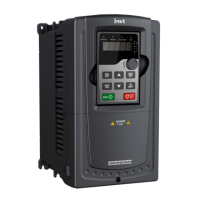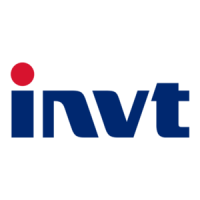
Do you have a question about the INVT GD200-037G/045P-4 and is the answer not in the manual?
Defines safety terms like Danger, Warning, and explains warning symbols used throughout the manual.
Outlines crucial safety rules for inverter operation, installation, and maintenance, including waiting times.
Provides guidelines for safe handling, installation, and placement of the inverter to prevent injury or damage.
Details safety precautions during the commissioning and operational phases of the inverter to ensure safe use.
Covers safety procedures for performing maintenance and replacing components on the inverter, emphasizing qualified personnel.
Provides instructions for the safe disposal of the inverter, noting the presence of heavy metals.
Guides users on checking the inverter package and contents for damage or missing items upon receipt.
Lists checks for the machine, load, and environmental conditions before installing and using the inverter.
Provides a checklist for verifying correct installation of the inverter and related components.
Outlines the essential steps for basic commissioning before the inverter's actual utilization.
Explains the fundamental operation principle of the inverter's main circuit, including rectifier and converter stages.
Lists detailed technical specifications including input, output, and control features of the inverter.
Illustrates and deciphers the information on the inverter's name plate and type designation.
Details electrical specifications, rated values, and provides a diagram of the inverter's internal structure.
Covers environment, direction, manner, single, multiple, vertical, and tilt installation configurations.
Covers main circuit wiring diagrams, terminal figures, and control circuit wiring practices.
Covers short-circuit protection, thermal overload protection, and bypass connection implementation.
Details keypad components like LEDs, display zones, potentiometer, and operational buttons for control and adjustment.
Explains how to operate the inverter via keypad, modify function codes, set passwords, and monitor states.
Details parameters for basic functions like speed control mode, run command channel, and communication selection.
Covers parameters for starting modes, frequency, braking, stopping behavior, and restart functions.
Details parameters for motor 1, including rated power, frequency, speed, voltage, current, and resistance.
Covers parameters specific to vector control mode, including speed loop, compensation, and torque settings.
Details parameters for SVPWM control, including V/F curves, torque boost, energy saving, and vibration control.
Details parameters for configuring digital input terminals, including function selection, polarity, and timing.
Details parameters for configuring digital and relay output terminals, including their functions, timing, and signal mapping.
Covers parameters for user interface, including password protection, parameter copy, display states, and software version.
Details parameters for enhanced functions like jogging, jumping frequency, traverse running, and pulse counter.
Covers PID control parameters, including reference source, feedback, output features, and tuning constants.
Details parameters for simple PLC and multi-step speed functions, including step settings and ACC/DEC times.
Details parameters for protective functions like phase loss, overvoltage, overload, and underload protection.
Describes the analog input terminals (AI1, AI2, AI3) and their filtering, maximum, and minimum value adjustments.
Details the analog output terminals (AO1, AO2) and pulse output, including filtering and value adjustment.
Explains the programmable digital input terminals and open-collector terminal, and how function codes program them.
Lists functions for relay and open-collector digital outputs based on set values, including running and fault signals.
Explains the Simple PLC function for automatic control of frequency and direction based on running time.
Details setting 16 step speeds using multi-step speed terminals and their corresponding parameters.
Illustrates PID control, explaining proportional, integral, and derivative adjustments for stable system control.
Explains the traverse running function, its applications, workflow, and related parameters.
Details pulse counter operation, including input via HDI terminal and output signals for length arrival.
Explains fixed-length control using pulse input, counting, and length arrival signals for automated processes.
Provides a flowchart for fault handling, estimating reasons, and seeking solutions from INVT support.
Explains how alarms and faults are indicated via LEDs and panel display, guiding users to identify causes.
Details methods for resetting inverter faults using the keypad, digital input, or power cycling.
Explains how recent faults and related operation data are stored in function codes for review.
Provides a systematic approach to diagnosing and resolving inverter faults by checking parameters and tables.
Lists and describes other fault codes like PoFF and communication failures, with their causes and solutions.
Provides troubleshooting steps for common motor-related faults like no-work, vibration, and heat.
Details troubleshooting for overvoltage, undervoltage, and overheating faults, including checks on power and cooling.
Outlines troubleshooting for overcurrent and motor stall during acceleration, checking parameters and loads.
Lists recommended routine maintenance checks and intervals for ambient environment, voltage, keypad, and main circuit.
Provides instructions for replacing the inverter's cooling fan, including safety precautions and diagrams.
Explains reforming DC bus capacitors after long storage and procedures for changing electrolytic capacitors.
Covers checking power cable connections and ensuring tightness after disconnecting power.
Provides an overview of MODBUS protocol, its modes, master-slave concept, and application in industrial networks.
Details RTU frame structure, bit checkout (even/odd), and CRC check for ensuring data integrity.
Explains command codes like 03H for reading and 06H for writing, detailing frame structures and examples.
Describes the 08H command code used for diagnosis, including sub-function codes and examples.
Illustrates the 10H command code for writing multiple data points continuously, with examples.
Explains how data addresses are defined for function codes, including rules for high and low bytes.
Lists parameter addresses for various functions, including communication control and setting values.
Explains fault message codes returned by the inverter to the master for communication errors.
Explains inverter sizing, limitations on shaft power, and how load capacity decreases with altitude and temperature.
Provides specifications for voltage ranges, frequency, and maximum short-circuit current capacity.
Lists motor types, voltage, protection, frequency, and carrier frequency specifications, including EMC cable length.
Lists the safety and machinery standards the inverter complies with, such as EN ISO 13849-1 and IEC/EN standards.
Details EMC product standards, CE marking, directive compliance, and inverter categories (C1-C4).
Shows the internal structure of the keypad and the chart for its installation on the inverter.
Provides diagrams and dimensions for wall, flange, and floor mounting of various inverter models.
Covers peripheral wiring, power supply reference, cable types, routing, and insulation checking.
Details selection of breakers, fuses, reactors, and filters for protecting the inverter and system.
Guides on selecting braking components, cables, resistors, units, and other optional parts like flange brackets.
Guides users on contacting local INVT offices for product inquiries, quoting type and serial numbers.
Encourages users to provide feedback on manuals via the INVT website's online feedback form.
Directs users to the INVT website for downloading manuals and product documents in PDF format.











